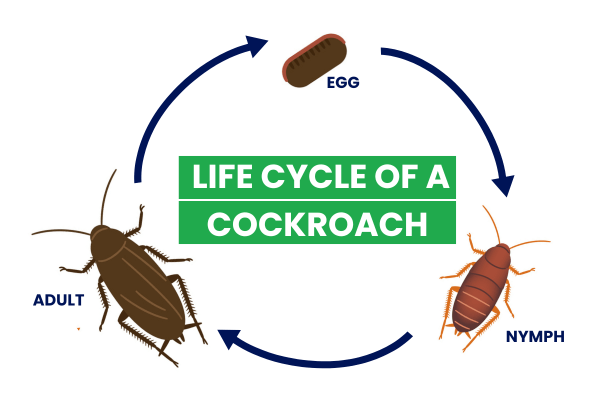Cockroach Lifecycle, Behavior, and Vulnerabilities: A Comprehensive Guide
Are you looking for effective roach control solutions? Call 0772593344 for affordable and reliable cockroach control solutions
Cockroaches, those ubiquitous and often reviled insects, are remarkably successful organisms. Their ability to thrive in diverse environments, from pristine homes to the dirtiest sewers, is a testament to their robust biology and adaptable behaviors. Understanding their lifecycle, behavior, and vulnerabilities is crucial for effective pest control and appreciating their ecological role, however unpleasant that role may be.
I. The Cockroach Lifecycle: From Egg to Adult
The cockroach lifecycle is a fascinating example of incomplete metamorphosis, meaning it lacks a pupal stage. The process unfolds across three distinct stages:

Egg Stage: Cockroaches reproduce sexually, with the female producing an ootheca, a protective, leathery case containing multiple eggs. The number of eggs varies depending on the species; some species produce just a few eggs per ootheca, while others can contain several dozen. The ootheca’s appearance also varies; it can be brown, black, or even reddish-brown, and its shape can be elongated, bean-shaped, or even almost spherical. The female may carry the ootheca until it’s close to hatching, attaching it to a substrate (like a crack in a wall or under an appliance) shortly before the nymphs emerge. The incubation period depends on environmental conditions like temperature and humidity and can range from a few weeks to several months.
Nymph Stage: Once hatched, the young cockroaches, called nymphs, resemble miniature versions of the adults, albeit wingless. They undergo a series of molts, shedding their exoskeleton as they grow. The number of molts varies across species and can range from five to thirteen. During each molt, the nymph increases in size and develops gradually toward the adult form. This stage can last several months, even a year or more depending on species and environmental factors. Nymphs are particularly vulnerable during and immediately after molting, as their new exoskeleton is soft and susceptible to damage.
Adult Stage: Upon reaching maturity, the cockroach undergoes its final molt, developing wings (in winged species) and reaching its full reproductive capacity. Adults are capable of mating and producing oothecae, continuing the cycle. The lifespan of an adult cockroach is species-dependent, ranging from a few months to over a year.
II. Cockroach Behavior: A Closer Look
Cockroaches exhibit a range of behaviors that contribute to their survival and success:
Nocturnal Activity: Most cockroach species are nocturnal, preferring to forage and move around primarily at night. This behavior helps them avoid predators and human interference.
Aggregation: Cockroaches often congregate in large groups, particularly around food sources and shelter. This behavior is likely driven by pheromones, chemical signals that attract other individuals.
Omnivorous Diet: Cockroaches are opportunistic feeders, consuming a wide variety of organic matter, including decaying plant material, scraps of food, paper, and even feces. Their ability to digest diverse food sources contributes significantly to their adaptability.
Escape Response: Cockroaches are incredibly quick and agile, boasting exceptional escape reflexes. They possess sensory organs that detect changes in air currents and vibrations, allowing them to quickly flee from perceived threats.
Environmental Tolerance: Cockroaches exhibit remarkable tolerance to harsh environments. Many species can survive on minimal food and water for extended periods, and some can even withstand significant doses of radiation.
Social Behavior (to a degree): While not highly social like ants or bees, some cockroach species demonstrate rudimentary social behaviors, including maternal care (guarding the ootheca) and aggregation.
III. Cockroach Vulnerabilities: Exploiting Weaknesses for Control
Despite their remarkable resilience, cockroaches have vulnerabilities that can be exploited for effective pest control:
Dehydration: While remarkably resistant to dehydration, cockroaches still require water to survive. Reducing moisture levels in a building is a crucial step in cockroach control.
Sensitivity to certain chemicals: Cockroaches are susceptible to various insecticides, including pyrethroids, organophosphates, and borates. However, resistance to these chemicals is an increasing concern, necessitating careful selection and rotation of insecticides.
Bait Stations: Cockroaches are attracted to food sources, making bait stations a useful control method. These stations contain insecticides mixed with attractive food lures, targeting cockroaches effectively.
Sanitation: Eliminating food sources and reducing clutter are crucial steps in cockroach control. Cleanliness reduces attractive harborage sites and food sources, making it harder for cockroaches to establish themselves.
Integrated Pest Management (IPM): IPM is a holistic approach that combines various control methods, including sanitation, monitoring, targeted insecticide application, and exclusionary measures (sealing cracks and crevices) to manage cockroach infestations effectively and sustainably.
IV. Conclusion:
Understanding the cockroach lifecycle, behavior, and vulnerabilities is key to effective pest management. While these insects are remarkably adaptable, their reliance on certain resources and their sensitivity to certain chemicals provide opportunities for their control. A multi-pronged approach that incorporates sanitation, careful insecticide use, and integrated pest management strategies is essential for long-term success in reducing cockroach infestations and mitigating the health risks associated with their presence. By understanding these often-overlooked creatures, we can better protect ourselves and our environments from the nuisances and potential health hazards they present.
